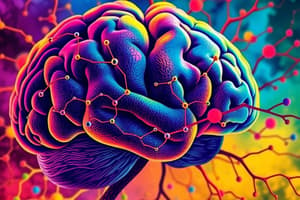Podcast
Questions and Answers
What are the main components of the nervous system?
What are the main components of the nervous system?
- Frontal and occipital lobes
- Temporal and parietal lobes
- Brain and spinal cord (correct)
- Central and peripheral nuclei
Where is the thalamus located?
Where is the thalamus located?
- Center of the brain (correct)
- Frontal lobe
- Temporal lobe
- Parietal lobe
Which part of the brain is involved in regulating body temperature, thirst, and hunger?
Which part of the brain is involved in regulating body temperature, thirst, and hunger?
- Occipital lobe
- Frontal lobe
- Hypothalamus (correct)
- Amygdala
What is the function of the amygdala?
What is the function of the amygdala?
Which part of the brain is responsible for involuntary functions like breathing and maintaining blood pressure?
Which part of the brain is responsible for involuntary functions like breathing and maintaining blood pressure?
Where does the spinal cord travel from and to?
Where does the spinal cord travel from and to?
What is the main function of the nervous system?
What is the main function of the nervous system?
Which part of the nervous system is responsible for regulating unconscious processes like digestion and heart rate?
Which part of the nervous system is responsible for regulating unconscious processes like digestion and heart rate?
What is the role of spinal nerves in the Peripheral Nervous System (PNS)?
What is the role of spinal nerves in the Peripheral Nervous System (PNS)?
Which part of the nervous system controls conscious movement of skeletal muscles?
Which part of the nervous system controls conscious movement of skeletal muscles?
What can be symptoms of nervous system disorders?
What can be symptoms of nervous system disorders?
How can one take care of their nervous system?
How can one take care of their nervous system?
Flashcards are hidden until you start studying
Study Notes
The nervous system is a complex network of cells and structures that transmit information throughout the body. It's responsible for controlling major bodily functions and enabling interactions with the external environment. The main components of the nervous system are the central nervous system (CNS) and the peripheral nervous system (PNS).
Central Nervous System (CNS)
The CNS comprises the brain and the spinal cord. The brain is the most complex organ in the body, containing an estimated 100 billion neurons connected to thousands more. It is divided into four main lobes: temporal, parietal, occipital, and frontal. The brain is protected by the skull (the cranial cavity) and the spinal cord travels from the back of the brain, down the center of the spine, stopping in the lumbar region of the lower back.
The brainstem extends below the skull and is involved in involuntary functions such as vomiting, breathing, sneezing, and maintaining correct blood pressure. The hypothalamus sits just above the brainstem and secretes neurohormones that influence body temperature control, thirst, and hunger. The thalamus is positioned in the center of the brain and relays sensory input to the rest of the cerebral cortex. It's involved in regulation of consciousness, sleep, awareness, and alertness. The amygdala are two almond-shaped nuclei deep within the temporal lobe, involved in decision-making, memory, and emotional responses, particularly negative emotions.
The spinal cord carries information between the brain and the body and contains circuits that control reflexive movements like walking when the brain is separated from the spine.
Peripheral Nervous System (PNS)
The PNS includes all nerves outside the brain and spinal cord. It consists of 31 spinal nerves that enter the cord along its length, connecting with peripheral nerves that run into the skin, muscles, and joints. Motor commands from the brain travel through these nerves, causing muscle contractions or relaxations for movement. Sensory information also travels through the PNS from sensory tissues to the brain.
Voluntary and Involuntary Nervous System
The nervous system can be further divided into voluntary and involuntary parts depending on their location in the body and the level of consciousness involvement. The voluntary nervous system, also known as the somatic nervous system, controls conscious movement of skeletal muscles. On the other hand, the involuntary nervous system, also known as the autonomic nervous system, regulates unconscious processes like digestion, heart rate, metabolism, and body temperature.
Nervous System Function
The main function of the nervous system is to receive information from various sources, process it, and generate appropriate responses. It uses neurons to transmit electrical signals throughout the body, enabling communication among different organs and systems.
Nervous System Disorders
Various conditions can affect the nervous system. Some common disorders include epilepsy, meningitis, multiple sclerosis, Parkinson's disease, sciatica, shingles, and stroke. Symptoms may vary depending on the condition but can include seizures, headache, vision problems, numbness, difficulty moving, speech changes, and cognitive impairments. Treatment typically involves a combination of medications, lifestyle modifications, and physical therapy.
Take care of your nervous system by engaging in regular exercise, maintaining a balanced diet, getting enough sleep, staying hydrated, and managing stress levels. Regular health checkups are crucial for detection and management of any potential issues early on.
Studying That Suits You
Use AI to generate personalized quizzes and flashcards to suit your learning preferences.



